Fenerbahçe S.K. (football)
Fenerbahçe S.K. (football)
Fenerbahçe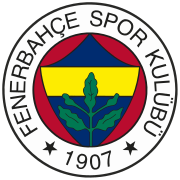 Full nameFenerbahçe Spor Kulübü
Full nameFenerbahçe Spor Kulübü
- (Fenerbahçe Sports Club)Nickname(s)Sarı Kanaryalar (The Yellow Canaries)
- Sarı Lacivertliler (The Yellow-Navy Blues)
- Efsane (The Legend)
- Fener (The Beacon of Light)
- Short nameFB
- Fener
Founded3 May 1907; 116 years ago[a][1][2]GroundŞükrü Saracoğlu StadiumCapacity47,834 (all-seater)[3]PresidentAli KoçHead coachİsmail KartalLeagueSüper Lig2022–23Süper Lig, 2nd of 19WebsiteClub website





























 Current seasonActive departments of Fenerbahçe S.K.
Current seasonActive departments of Fenerbahçe S.K.

 AthleticsBasketball
AthleticsBasketball
(Men's)
(Women's)Boxing

 EsportsFootball
EsportsFootball
(Men's)
(Men's U21)
(Men's Academy)
(Women's)Rowing

 SailingSwimmingTable Tennis
SailingSwimmingTable Tennis Volleyball
Volleyball
(Men's)
(Women's)
Fenerbahçe Spor Kulübü (Turkish: [feˈnæɾbahtʃe], Fenerbahçe Sports Club) is a Turkish professional football club based in Kadıköy, Istanbul, Turkey. They represent the men's football department of Fenerbahçe S.K., a prominent multi-sport club. Fenerbahçe, also referred to colloquially as Fener, has never been relegated from the top division of Turkish football and currently competes in the Turkish Super League, the Turkish Cup, the Turkish Super Cup and UEFA Europa Conference League.
Fenerbahçe is nicknamed Sarı Kanaryalar (Turkish for "Yellow Canaries") and plays its home games at Şükrü Saracoğlu Stadium, a traditional home ground granted to the club by the mayor of Istanbul in 1994. The stadium is based in Kadıköy, Istanbul. The club's name translates as "Lighthouse in the Garden" and comes from the Fenerbahçe neighbourhood of the Kadıköy district in Istanbul.
Fenerbahçe is one of the most successful Turkish clubs having won a record 19 Turkish championship titles. The club also sits at the first place in Süper Lig all-time table.
In international club football, Fenerbahçe has won the Balkans Cup in 1968, which is marked as the first ever non-domestic trophy won by a Turkish football club. In UEFA competitions, Fenerbahçe has reached the quarter-finals in the 1963–64 UEFA Cup Winners' Cup and in the 2007–08 UEFA Champions League, and has reached the semi-finals in the 2012–13 UEFA Europa League. Fenerbahçe is a member of the European Club Association.
Fenerbahçe is one of the most popular football clubs in Turkey.[4] They boast a large fanbase throughout the country, as well as in Northern Cyprus,[5][6] Azerbaijan,[7] and in the Turkish diaspora.[8][9] In their home at the Şükrü Saracoğlu Stadium, Fenerbahçe's average attendances have always been among the highest in Turkey.[10][11] Fenerbahçe's most intense rivalries is with their major neighbors, Galatasaray and Beşiktaş. Matches between Fenerbahçe and Galatasaray are often referred to as The Intercontinental Derby and are widely regarded as one of the fiercest and most intense derbies globally.[12][13] Matches against Beşiktaş are also derbys, and the two teams share a longstanding rivalry.
History[edit]
Early years 1907–1959[edit]
 Ziya Songülen the founder and first president
Ziya Songülen the founder and first president
Fenerbahçe were founded in 1907 in Kadıköy, Istanbul, by local men Ziya Songülen, Ayetullah Bey and Necip Okaner. This group founded the club secretly in order to keep a low profile and not get into any trouble with the strict Ottoman rule, so strict that the Sultan Abdul Hamid II forbade the Turkish youth to set up a club or engage in the game of football played by the English families that was watched in envy. The three men came together and concluded that Kadıköy was in desperate need of its own football club, where locals would get a chance to practise the game of football. Ziya Songülen was elected the first president of the club, Ayetullah Bey became the first general secretary and Necip Okaner was given the post of general captain.[14] The first team in 1908
The first team in 1908
The lighthouse situated on the Fenerbahçe cape was a big influence on the design of the club's first crest, which sported the yellow and white colors of daffodils around the lighthouse. The kits were also designed with yellow and white stripes.[14] The crest of the club was changed in 1910 when Hikmet Topuzer redesigned the badge after Ziya Songülen had changed the colors to yellow and navy in the fall of 1909, still seen today. Fenerbahçe's activities were kept in secrecy until a legislation reform in 1908, when, under a new law, all football clubs had to register to exist legally.[14]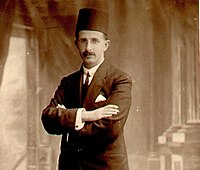 Ayetullah Bey the founder and second president
Ayetullah Bey the founder and second president
The founding line-up included Ziya Songülen, Ayetullah Bey, Necip Okaner, Galip Kulaksızoğlu, Hassan Sami Kocamemi, Asaf Beşpınar, Enver Yetiker, Şevkati Hulusi Bey, Fuat Hüsnü Kayacan, Hamit Hüsnü Kayacan and Nasuhi Baydar.[15]
Struggling with financial difficulties, Fenerbahçe joined the Istanbul Football League in 1909, finishing fifth in their first year. The first coach of the Fenerbahçe was Hüseyin Dalaklı, who was also the team's player. Fenerbahçe won the 1911–12 season of the Istanbul Football League without losing. This championship was the clubs first success in their long history. In the 1913–14 and 1914–15 seasons, the team under the coaching of Galip Kulaksızoğlu won the Istanbul Football League. Fenerbahçe finished the seasons 1920–21 and 1922–23 as champions in the Istanbul Friday League. Fenerbahçe completed the season with a score of 58–0 without losing or conceding goals in the season of 1922–23.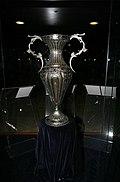
Fenerbahçe played against the staff of the Royal Navy that occupied Istanbul during the Turkish War of Independence. Some British soldiers formed football teams that were named after the players' speciality, for example Essex Engineers, Irish Guards, Grenadiers and Artillery. These teams played against each other and against local football teams in Istanbul. Fenerbahçe won many of these matches.[16] The most known match played against the British was the match that would determine the winner of the General Harrington Cup. Fenerbahçe won the match held on 29 June 1923 at Taksim Stadium with two goals scored by Zeki Rıza Sporel, one of the important players of the period.[17]
Fenerbahçe won the championship 6 times in 1937, 1940, 1943, 1945, 1946 and 1950, and became the team that achieved the most victories in the Turkish National Division. Lefter Küçükandonyadis, one of the important names of Fenerbahçe, scored 423 goals in 615 matches between 1947–1951 and 1953–64.
Fenerbahçe won the Istanbul Football League 16 times, the Turkish National Division 6 times, and the former Turkish Football Championship 3 times, all of them records, profiling themselves as forerunners and dominating side in Turkish football before the introduction of the professional nationwide league in 1959.[18][19]
1959–1969[edit]
 Under the guidance of Ignác Molnár, the club won many trophies
Under the guidance of Ignác Molnár, the club won many trophies
The Turkish Football Federation founded a professional national league in 1959, which continues today under the name of the Süper Lig. Fenerbahçe won the first tournament, beating archrivals Galatasaray 4–1 on aggregate.[20] The next year, Fenerbahçe participated in the European Cup for the first time. They qualified through a 4–3 win over Csepel SC, being the first Turkish club to advance to the next round by eliminating its opponent. They lost their first-round match to Nice 1–5 in a playoff game after drawing on aggregate.[21] Fenerbahçe reached the quarter-final of the 1963–64 European Cup Winners' Cup where it was eliminated by MTK Budapest.
Fenerbahçe won four more league titles in the 1960s and were runners-up three times, making it the most successful club of that era.[22][23] Fenerbahçe was coached by Ignác Molnár at the time, a famous Hungarian coach who had introduced a new style of football in Turkey. Under his guidance, Fenerbahçe managed to eliminate English champions Manchester City in the first round of the 1968–69 European Cup. Fenerbahçe's Balkan Cup championship
Fenerbahçe's Balkan Cup championship
In the 1966–67 Balkans Cup (a competition set up for Eastern European clubs from Albania, Bulgaria, Greece, Romania, Turkey and Yugoslavia that existed between the 1960–61 and 1993–94 seasons), Fenerbahçe won the cup after three final matches against Greek club AEK Athens, making them the first Turkish club to win a non-domestic competition. This success would remain unparalleled by a Turkish club until Sarıyer and Samsunspor won the cup many years later in the 1990s, when the competition lost much of its popularity.[24]
Later years[edit]
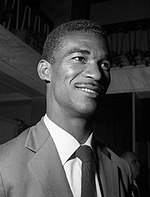 Didi coached the club between 1972 and 1975, winning eight trophies
Didi coached the club between 1972 and 1975, winning eight trophies
The 1970s saw Fenerbahçe bring in the famous Didi as their new coach. Fenerbahçe won four more league titles, including a double with Cemil Turan being the top goal scorer three times. The 1970s also established a rivalry with Trabzonspor, where for almost a decade Fenerbahçe and Trabzonspor were competing with each other for the title. The 1980s saw Fenerbahçe win three more league titles. Under the guidance of Kálmán Mészöly, Fenerbahçe managed to eliminate French champions Bordeaux in the first round of the 1985–86 European Cup.[25][26] This victory marked a turning point as for almost a decade no Turkish club managed to get past the first round in European competitions.
Galatasaray and Beşiktaş dominated the Turkish League during the 1990s, combining to win nine out of ten titles. Fenerbahçe's only Turkish League success during the 1990s came in the 1995–96 season under the guidance of Carlos Alberto Parreira.[22][23] In the 1996–97 UEFA Champions League season, Fenerbahçe completed the group stage with seven points[27] and, among others, defeated Manchester United 1–0 at Old Trafford, undoing the record of the English giants being unbeaten for 40 years in their homeground.[28]
Fenerbahçe won the league title in 2001, denying Galatasaray a fifth consecutive title. It followed up the next season with a second-place behind Galatasaray with new coach Werner Lorant. However, the next season did not go so well as Fenerbahçe finished in sixth place.[29] Despite this, that season is memorable to many Fenerbahçe fans due to a 6–0 win against arch-rivals Galatasaray at the Şükrü Saracoğlu Stadium on 6 November 2002.[30] After firing Werner Lorant, the club hired another German coach, Christoph Daum. Daum had previously coached in Turkey, winning the league with Beşiktaş in 1994–95. Fenerbahçe brought in players including Pierre van Hooijdonk, Mehmet Aurélio and Fábio Luciano as a rebuilding process. These new players lead Fenerbahçe to its 15th title and third star (one being awarded for every five league titles won by a club).[31] 100th year celebration of the club
100th year celebration of the club
The next year was followed by a narrow championship over Trabzonspor, winning a then record 16 Turkish Football League championships.[32] Fenerbahçe lost the title in the last week of the 2005–06 season to Galatasaray. Fenerbahçe needed a win, but instead drew 1–1 with Denizlispor while Galatasaray won 3–0 over Kayserispor. Soon after, Christoph Daum resigned as manager[33] and was replaced by Zico on 4 July 2006.[34][35] Zico began his reign by signing two new defenders: highly touted Uruguayan international Diego Lugano and Zico's fellow Brazilian Edu Dracena.[36] Zico also signed two strikers in Serbian international Mateja Kežman and another Brazilian, Deivid.[37] Fenerbahçe's 2006–07 domestic season started with a 6–0 win over relegation candidates Kayseri Erciyesspor.[38] In the 32nd week of the Süper Lig, Fenerbahçe drew Trabzonspor 2–2, while Beşiktaş lost to Bursaspor 0–3, putting the former out of contention for the title.[39][40] Fenerbahçe won its 17th Süper Lig title in 2006–07.[41]
2007–present[edit]
 Zico coached the club between 2006 and 2008
Zico coached the club between 2006 and 2008 Roberto Carlos played for the club between 2007 and 2009
Roberto Carlos played for the club between 2007 and 2009 Fenerbahçe against Chelsea in the second leg of the 2007–08 UEFA Champions League quarter-finals which they lost 2–0
Fenerbahçe against Chelsea in the second leg of the 2007–08 UEFA Champions League quarter-finals which they lost 2–0
On 11 January 2007, Fenerbahçe were officially invited to G-14.[42] G-14 was an association which consists of top European clubs.
Under Zico's command, Fenerbahçe qualified from the 2007–08 Champions League group stage for the first time and went on to beat Sevilla to become a quarter-finalist in the 2007–08 season. Zico is also the most successful manager of the team's history in the Champions League. After successful scores both in the Turkish league and international matches, Zico gained a new nickname from the Fenerbahçe fans: Kral Arthur (meaning "King Arthur" in Turkish).[43] In February 2009, Fenerbahçe became the first Turkish club to enter the Deloitte Football Money League.[44] Since 2000, Fenerbahçe improved the club's finances and facilities, bringing world stars to the club such as Ariel Ortega, Pierre van Hooijdonk, Alex, Stephen Appiah, Nicolas Anelka and, more recently, Mateja Kežman, Roberto Carlos, Dani Güiza, Dirk Kuyt, Diego, Nani, Robin van Persie, and Mesut Özil.
In the 2009–10 season Fenerbahçe lost the title on the last matchday; Fenerbahçe players were told that a draw would be enough towards the end of the match only to find out that the other critical game went against their favour, as Bursaspor beat Beşiktaş 2–1 to win the title. Despite the title loss, Fenerbahçe ended the season with the most clean sheets (10), as well as the joint longest winning streak (8).[45] In July 2011, Fenerbahçe fans invaded the pitch during a friendly against the Ukrainian champions Shakhtar Donetsk. As punishment, Fenerbahçe were sentenced to two Süper Lig games in an empty stadium. The TFF later allowed those two games to be filled with spectators; men were barred, while women and children under 12 were admitted for free.[46] On 29 October 2012, Antalyaspor ended Fenerbahçe's 47-match unbeaten run in the Süper Lig at the Şükrü Saracoğlu Stadium. Fenerbahçe had not lost a match at home since they were beaten 2–3 by eventual champions Bursaspor in week 22, on 22 February 2010. Fenerbahçe won 38 and drew 9 in the 47 matches they played within 980 days since 22 February 2010.[47] On 3 November 2012, Fenerbahçe pecked Akhisar Belediyespor to break a 181-day away jinx.[48] On 2 May 2013, Fenerbahçe were eliminated by Benfica 3–2 on aggregate in the semi-final of the 2012–13 Europa League, one of the biggest successes in Fenerbahçe's history in UEFA competitions.[49]
On 28 June 2013, Ersun Yanal agreed to take charge of Fenerbahçe to replace Aykut Kocaman, who resigned in late May.[50][51] Ersun Yanal's appointment coincided with tough times for Fenerbahçe, who had just been banned from European competitions for two seasons over their alleged involvement in a domestic sports corruption scandal. Fenerbahçe, which finished second in the Süper Lig in 2012–13, thus missed-out on the 2013–14 Champions League, which it had been due to enter in the third qualifying round.[52] Fenerbahçe finished the 2014–15 season as runners-up, forcing the board of directors to undertake some major changes. For the 2015–16 season, Fenerbahçe brought in Vítor Pereira as their new coach. Portuguese star Nani, Danish defender Simon Kjær and Robin van Persie were added to the squad to fulfill the club's ambitions to be successful in the Süper Lig and European competitions. On 10 December 2015, Fenerbahçe played their 200th European game against Celtic.[53] On 12 October 2022, Fenerbahçe played their 250th European game against AEK Larnaca.[54]
Former notable players[edit]
Main article: List of Fenerbahçe S.K. players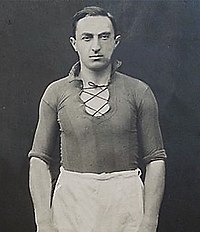 Zeki Rıza Sporel, all-time top scorer of Fenerbahçe
Zeki Rıza Sporel, all-time top scorer of Fenerbahçe
 Cemil Turan, one of the best players of the 1970's.
Cemil Turan, one of the best players of the 1970's.
When it was first founded in 1907, Fenerbahçe had a large squad. One of these players, Galip Kulaksızoğlu, was the longest serving player of the original squad, spending 17 years at the club, retiring in 1924 after 216 matches.[55] Zeki Rıza Sporel and Bekir Refet, the first Turkish footballer ever to play abroad, were among the first products of the Fenerbahçe youth system. During his 18-year career with the club, Zeki Rıza scored 470 goals in 352 matches, or 1.3 goals every match, making him the all-time top scorer of Fenerbahçe.[55] Zeki Rıza was also capped for the Turkish national team 16 times, scoring 15 goals. Cihat Arman became the first in a long-line of long-serving goalkeepers, playing 12 seasons and in 308 matches with the club.[55] Lefter Küçükandonyadis was one of the first Turkish football players to play in Europe. Lefter spent two seasons in Europe, playing for Fiorentina and Nice before returning to Fenerbahçe. All in all, Lefter scored 423 goals in 615 matches for the club, helping them to two Istanbul Football League titles and three Turkish League titles.
Another notable player, Can Bartu, became the next big Turkish export to Europe. He was also the first Turkish football player to play in a European competition final, doing so with Fiorentina against Atlético Madrid in 1962. Can also spent some seasons playing for Venezia and Lazio before returning to Fenerbahçe in 1967. He was a four-time league champion with Fenerbahçe and scored 162 goals in 330 matches. Some of the other most notable Turkish players who played for Fenerbahçe include: Fikret Arıcan, Fikret Kırcan, Halit Deringör, Melih Kotanca, Burhan Sargun, Nedim Doğan, Cemil Turan, Selçuk Yula, Müjdat Yetkiner, Oğuz Çetin, Rıdvan Dilmen, Aykut Kocaman, Rüştü Reçber and Tuncay Şanlı. Alex, captain of Fenerbahçe from 2007 to 2012 and the most successful foreign player in the history of the club and the Turkish Super League
Alex, captain of Fenerbahçe from 2007 to 2012 and the most successful foreign player in the history of the club and the Turkish Super League
Former Romania goalkeeper Ilie Datcu was the first foreigner to reach 100 caps for Fenerbahçe. In recent decades, Fenerbahçe have gained an influx of foreigners who have helped the club to 19 Süper Lig titles. Among these include Uche Okechukwu, who after 13 seasons with Fenerbahçe and İstanbulspor became the longest serving foreigner in Turkey. During Uche's career with Fenerbahçe, he won two league titles and became a fan favourite. More recently, Fenerbahçe have been the home to Brazilian-born Mehmet Aurélio who, in 2006, became the first naturalized Turkish citizen to play for the Turkish national team.[56]
Alex is another Brazilian player who scored the most goals of all foreign players who have played for Fenerbahçe. He managed to become top scorer of the Turkish Süper Lig on two occasions (in 2006–07 and 2010–11), Turkish Footballer of the Year twice (in 2005 and 2010), as well as assist leader in the 2007–08 season of the UEFA Champions League.[57] Based on all those achievements, as well as his exemplary character and sportsmanship on and off the field, acknowledged by fans of Fenerbahçe and their rivals alike, he became the most successful and renowned foreign player to have ever played for the club and one of a few whose statue has been erected by the supporters of the club in the Yoğurtçu Park, in the near of Şükrü Saracoğlu Stadium.[58] Some of the other foreign top players who played for Fenerbahçe over the years include: Toni Schumacher (1988–91), Jes Høgh (1995–99), Jay-Jay Okocha (1996–98), Elvir Bolić (1995–2000), Kennet Andersson (2000–02), Ariel Ortega (2002–03), Pierre van Hooijdonk (2003–05), Nicolas Anelka (2005–06), Stephen Appiah (2005–08), Mateja Kežman (2006–09), Diego Lugano (2006–11), Roberto Carlos (2007–09), Dirk Kuyt (2012–15), Robin van Persie (2015–2018) and Nani (2015–16).
Support[edit]
Main article: Fenerbahçe S.K. supporters Fenerbahçe supporters in the derby match against Beşiktaş
Fenerbahçe supporters in the derby match against Beşiktaş
Fenerbahçe have developed a strong following since their foundation in 1907. They are one of the most popular clubs in Turkey, with about 35% of the fans supporting them, and the most popular in Istanbul and Ankara.[59] They have a large fanbase throughout the country, in Northern Cyprus, Azerbaijan and in the Turkish diaspora.[60] Since the rebuilding of the Şükrü Saracoğlu Stadium, Fenerbahçe's average attendances have been among the highest in Turkey.[61]
Fenerbahçe have several supporter organisations, including Genç Fenerbahçeliler (GFB), Kill For You (KFY), Antu/Fenerlist, EuroFeb (Fenerbahçe supporters in Europe), Group CK (Cefakâr Kanaryalar), 1907 ÜNİFEB, Vamos Bien, and SUADFEB. Many fanzines, blogs, podcasts, forums and fan websites have been dedicated to the club.
Relationships with other clubs[edit]
More recently, in November 2011 Fenerbahçe's Genç Fenerbahçeliler created a friendly relationship with Torcida Sandžak, the organized supporters of Serbian club Novi Pazar. During a Süper Lig match against İstanbul Büyükşehir Belediyespor at the Şükrü Saraçoğlu Stadium, the Genç Fenerbahçeliler and 1907 Gençlik stand deployed a giant banner reading "Kalbimiz Seninle Novi Pazar" ("Novi Pazar, Our Hearts Are With You")[62] and later, in the game against Radnicki Kragujevac in the Serbian SuperLiga, Torcida Sandžak members deployed a giant banner reading "Sancak'ta atıyor, Fenerbahçe'nin kalbi" ("The heart of Fenerbahçe beats in Sandžak").[63] On 2 March 2012, Fenerbahçe's Genç Fenerbahçeliler and 1907 Gençlik members were invited to Novi Pazar for the match against Partizan in the Serbian SuperLiga. Thousands of Torcida Sandžak members welcomed Genç Fenerbahçeliler and 1907 Gençlik's 17 members.[64]
There is an informal friendship and fraternization between the fans of AEK and Fenerbahçe. In the 2017 Euroleague final, Fenerbahçe S.K. supporters displayed a banner which read "Same City's Sons"[65][66]



































